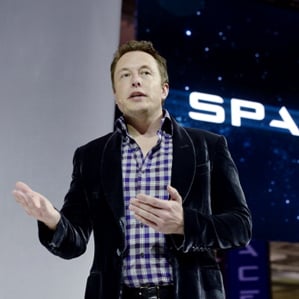Why the Time Seems Right for a Space-Based Internet Service
Providing Internet access from orbiting satellites—a concept that seemed to have died with the excesses of the dot-com boom—has returned thanks to SpaceX founder (and dot-com billionaire) Elon Musk. And while such a service would be expensive and risky to deploy, recent technological trends mean it’s no longer so out-of-this-world.

Musk has proposed a network of some 4,000 micro-satellites to provide broadband Internet services around the globe. SpaceX is partnering with Google and Fidelity Investments, which are investing $1 billion for a 10 percent stake in the endeavor. Richard Branson’s Virgin Galactic and Qualcomm, meanwhile, are investing in a competing venture called OneWeb, which aims to build a similar network of micro-satellites.
In the late 1990s there were plans to deliver similar space services. “The dot-com bust dried up their financing and it never really got off the ground,” says Forecast International analyst Bill Ostrove. Those projects might have failed anyway, though, because it costs $60 million and $70 million to launch a satellite, and there’s always a decent chance that the payload will be lost to an accident.
Fiber-optic cables, in contrast, are easy and cheap to install, even in harsh environments like the ocean floor, and they can transmit huge amounts of data. Beaming data from a satellite is done by radio, and is limited by the available spectrum, as well as the amount of power a satellite can get from its solar panels. Most communications satellites have data-transfer speeds of around a gigabit per second, compared to several terabits per second for the fastest fiber.
But some things have changed since the late 1990s. For one thing, satellite technology has advanced, bringing the cost of deployment down significantly. Toaster-sized micro-satellites can be launched dozens at a time, and don’t have to operate at very high orbits, reducing launch costs, but they can deliver performance comparable to larger, older satellites at higher altitudes.
SpaceX and Virgin Galactic also hope to ride a different boom by targeting parts of the world where there is little infrastructure and a huge opportunity for Internet growth. Satellite services remain less economical in areas where fiber-optic networks are in place, but Musk has stated that his Internet service would be aimed primarily at providing service to remote areas of the globe.
“You’ve got large swaths of land where there is a relatively low density of users,” Musk told an audience at the opening of SpaceX’s new satellite development center in Seattle last week. “Space is actually ideal for that.”
Musk and Branson are not alone in recognizing the market potential. Besides investing in Musk’s project, Google is working on a high-altitude balloon-based Internet delivery system called Loon. And Facebook is developing high-altitude, high-endurance drones to deliver Internet capability to remote areas. The Google and Facebook projects would be similar in concept to the space-based systems, while operating within the Earth’s atmosphere.
Whether, as Musk has suggested, SpaceX’s service could also be a viable alternative for customers in the developed world is less certain. Ostrove says satellites simply cannot compete with the bandwidth and low cost of fiber-optic cables.
The technology could also prove tricky for these newcomers to master. SpaceX, after all, has built rockets—but no satellites yet.
Keep Reading
Most Popular
Large language models can do jaw-dropping things. But nobody knows exactly why.
And that's a problem. Figuring it out is one of the biggest scientific puzzles of our time and a crucial step towards controlling more powerful future models.
The problem with plug-in hybrids? Their drivers.
Plug-in hybrids are often sold as a transition to EVs, but new data from Europe shows we’re still underestimating the emissions they produce.
Google DeepMind’s new generative model makes Super Mario–like games from scratch
Genie learns how to control games by watching hours and hours of video. It could help train next-gen robots too.
How scientists traced a mysterious covid case back to six toilets
When wastewater surveillance turns into a hunt for a single infected individual, the ethics get tricky.
Stay connected
Get the latest updates from
MIT Technology Review
Discover special offers, top stories, upcoming events, and more.